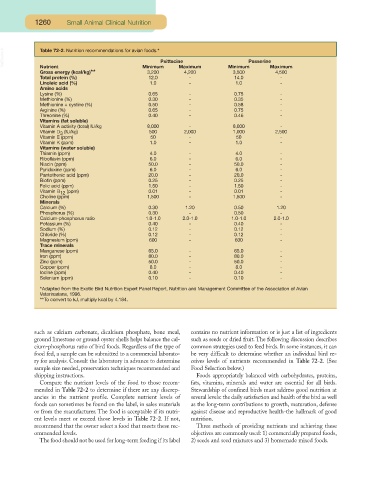Page 1210 - Small Animal Clinical Nutrition 5th Edition
P. 1210
1260 Small Animal Clinical Nutrition
VetBooks.ir Table 72-2. Nutrition recommendations for avian foods.* Psittacine Passerine
Nutrient
Gross energy (kcal/kg)** Minimum Maximum Minimum Maximum
3,500
4,200
3,200
4,500
Total protein (%) 12.0 - 14.0 -
Linoleic acid (%) 1.0 - 1.0 -
Amino acids
Lysine (%) 0.65 - 0.75 -
Methionine (%) 0.30 - 0.35 -
Methionine + cystine (%) 0.50 - 0.58 -
Arginine (%) 0.65 - 0.75 -
Threonine (%) 0.40 - 0.46 -
Vitamins (fat soluble)
Vitamin A activity (total) IU/kg 8,000 - 8,000 -
Vitamin D (IU/kg) 500 2,000 1,000 2,500
3
Vitamin E (ppm) 50 - 50 -
Vitamin K (ppm) 1.0 - 1.0 -
Vitamins (water soluble)
Thiamin (ppm) 4.0 - 4.0 -
Riboflavin (ppm) 6.0 - 6.0 -
Niacin (ppm) 50.0 - 50.0 -
Pyridoxine (ppm) 6.0 - 6.0 -
Pantothenic acid (ppm) 20.0 - 20.0 -
Biotin (ppm) 0.25 - 0.25 -
Folic acid (ppm) 1.50 - 1.50 -
Vitamin B 12 (ppm) 0.01 - 0.01 -
Choline (ppm) 1,500 - 1,500 -
Minerals
Calcium (%) 0.30 1.20 0.50 1.20
Phosphorus (%) 0.30 - 0.50 -
Calcium-phosphorus ratio 1.0-1.0 2.0-1.0 1.0-1.0 2.0-1.0
Potassium (%) 0.40 - 0.40 -
Sodium (%) 0.12 - 0.12 -
Chloride (%) 0.12 - 0.12 -
Magnesium (ppm) 600 - 600 -
Trace minerals
Manganese (ppm) 65.0 - 65.0 -
Iron (ppm) 80.0 - 80.0 -
Zinc (ppm) 50.0 - 50.0 -
Copper (ppm) 8.0 - 8.0 -
Iodine (ppm) 0.40 - 0.40 -
Selenium (ppm) 0.10 - 0.10 -
*Adapted from the Exotic Bird Nutrition Expert Panel Report, Nutrition and Management Committee of the Association of Avian
Veterinarians, 1996.
**To convert to kJ, multiply kcal by 4.184.
such as calcium carbonate, dicalcium phosphate, bone meal, contains no nutrient information or is just a list of ingredients
ground limestone or ground oyster shells helps balance the cal- such as seeds or dried fruit. The following discussion describes
cium-phosphorus ratio of bird foods. Regardless of the type of common strategies used to feed birds. In some instances, it can
food fed, a sample can be submitted to a commercial laborato- be very difficult to determine whether an individual bird re-
ry for analysis. Consult the laboratory in advance to determine ceives levels of nutrients recommended in Table 72-2. (See
sample size needed, preservation techniques recommended and Food Selection below.)
shipping instructions. Foods appropriately balanced with carbohydrates, proteins,
Compare the nutrient levels of the food to those recom- fats, vitamins, minerals and water are essential for all birds.
mended in Table 72-2 to determine if there are any discrep- Stewardship of confined birds must address good nutrition at
ancies in the nutrient profile. Complete nutrient levels of several levels: the daily satisfaction and health of the bird as well
foods can sometimes be found on the label, in sales materials as the long-term contributions to growth, maturation, defense
or from the manufacturer. The food is acceptable if its nutri- against disease and reproductive health-the hallmark of good
ent levels meet or exceed those levels in Table 72-2. If not, nutrition.
recommend that the owner select a food that meets these rec- Three methods of providing nutrients and achieving these
ommended levels. objectives are commonly used: 1) commercially prepared foods,
The food should not be used for long-term feeding if its label 2) seeds and seed mixtures and 3) homemade mixed foods.

